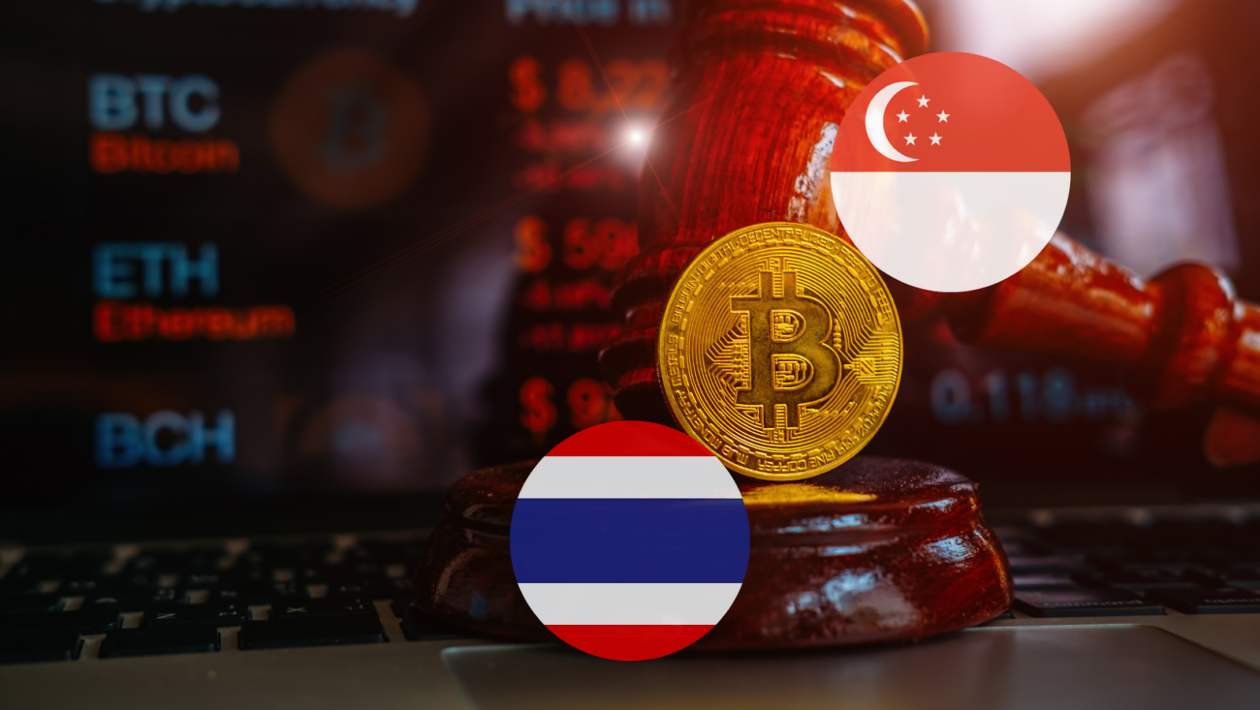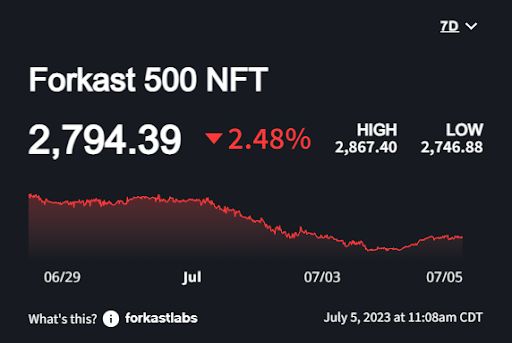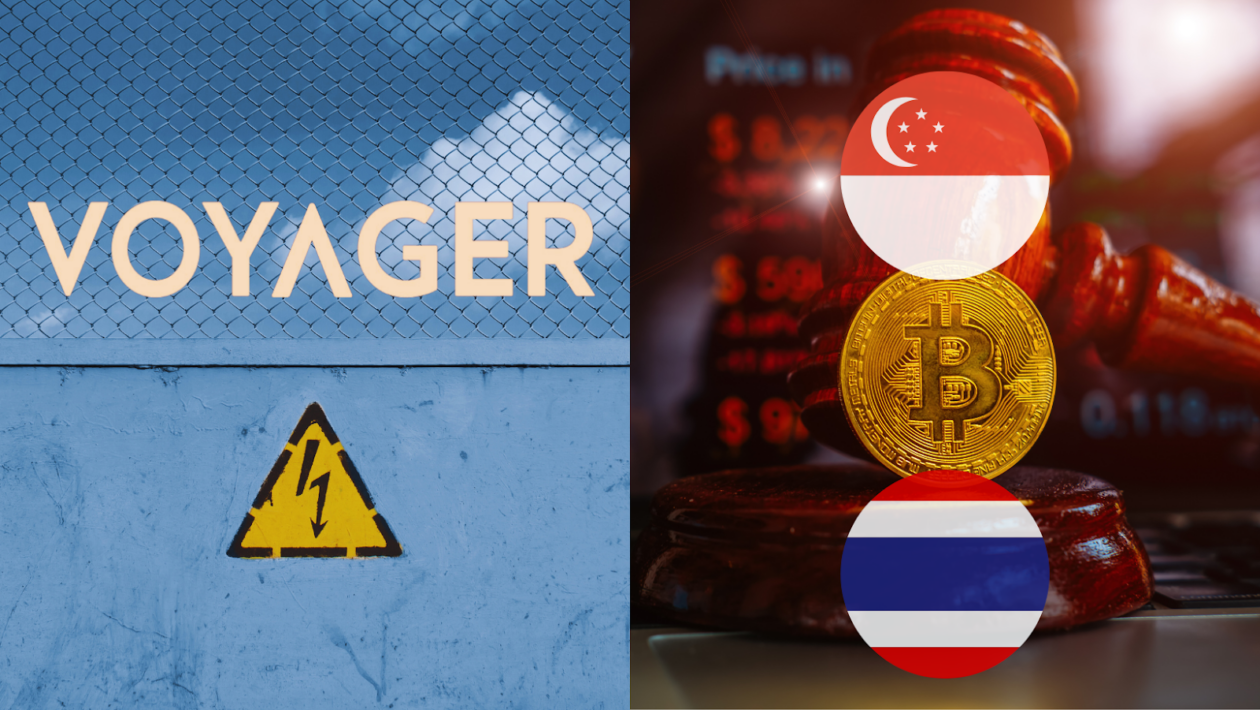In this issue
- Crypto regulation: Singapore, Thailand tighten measures
- Forkast 500 NFT Index: Seemingly no end to declines
- Voyager: Shrinking portfolio
From the Editor’s Desk
Dear Reader,
Regulatory developments in the Asian cryptocurrency space have come thick and fast in the past few days, with authorities in Singapore and Thailand announcing customer protection measures that impose new responsibilities and restrictions on crypto companies.
Singapore’s requirement that companies providing crypto services ringfence their customers’ assets from their own and ensure they are held in trust is no more onerous than rules under which mainstream banks have operated for almost a century. As such, they make sense — after all, practices that flouted those norms played a role in the hugely costly demise of FTX.
Thailand’s ban on crypto companies offering lending and staking products — a prohibition that the Monetary Authority of Singapore announced it also intended to impose — amounts to a stricter application of discipline to the crypto industry.
As we observe in this week’s edition of The Current Forkast, Thai finance sector authorities may be haunted by the careening currency crisis that began in their country back in 1997 and engulfed the entire region. But that’s unlikely to be the only reason for this week’s flurry of regulatory activity in not one but two jurisdictions. Nor does it explain a vote by South Korean lawmakers last week to approve beefed-up customer protection measures in the crypto space.
In seeking to understand what lies behind all this action, we could do worse than look to the U.S., where the mess left by the collapse of crypto lending platforms Voyager and Celsius is still very much being cleaned up.
Voyager was one among a number of crypto lenders and staking services propelled into a doom loop by the downfall of Three Arrows Capital and the infamous algorithmic stablecoin run by the Terraform Labs.
The fact that both Three Arrows and Terra were headquartered in a tropical Southeast Asian finance hub that was at the time also regarded as a center for crypto doesn’t explain this week’s announcement by the Monetary Authority of Singapore, that tropical finance hub’s de facto central bank. But a certain circularity is unmistakable as regulation takes shape in the region that the two companies used to call home.
It seems that regulators in Singapore and Thailand may have learned from the kinds of problems their U.S. counterparts have so far only tried to sue their way out of.
It seems that their preferred solution to potential problems in the crypto space is regulating, not just litigating.
And it seems impossible not to ask when we might see such an approach take root in Washington.
Until the next time,
Angie Lau,
Founder and Editor-in-Chief
Forkast.News
1. Doubling down

Crypto regulations have tightened in Singapore and Thailand this week, in measures aimed at enhancing customer assets. The Monetary Authority of Singapore (MAS) now mandates crypto firms to hold customer assets in third-party trusts, while Thailand’s Securities and Exchange Commission (SEC) has introduced bans on crypto lending and staking services.
- In a Monday press release, MAS stated that digital payment token service providers, — the term used by Singaporean officials for crypto assets — must safeguard customer assets under a segregated, statutory trust by year-end. The MAS said this move aims to “mitigate the risk of loss or misuse of customer assets” and facilitate asset recovery in the event of insolvency of a crypto service provider.
- MAS also intends to prohibit crypto service providers from offering crypto asset-based lending and staking services to retail investors, considering such services “generally not suitable for retail public.”
- Also on Monday, Thailand’s SEC announced rules to ban crypto firms from providing custodial services that yield returns to depositors and lenders, which would cover both crypto lending and staking.
- Effective from July 31, the rules also require crypto firms to display a disclaimer that reads, “Cryptocurrencies are high risk. Please study and understand the risks of cryptocurrencies thoroughly, because you may lose your entire investment.”
- The moves by Singapore and Thailand came after a series of crypto lender insolvencies in the past year, including the collapses of Celsius Network, Voyager Digital, BlockFi and more, which involved multiple billions of U.S. dollars in crypto deposits.
- Beyond the two Southeast Asian nations, South Korean legislators approved a bill last week aimed at protecting cryptocurrency investors, marking the country’s first step towards establishing a legal framework dedicated to the asset class. The new legislation mandates crypto service providers to implement specific measures to safeguard customer assets and maintain comprehensive records of all transactions.
Forkast.Insights | What does it mean?
The Monetary Authority of Singapore’s (MAS’s) announcement of more stringent customer protection measures in the crypto space should have come as no surprise.
As we noted in last week’s edition of The Current Forkast, the de facto central bank’s vision for digital assets is about as far removed as it is possible to get from the libertarian ideals that spawned the crypto and digital asset phenomenon, handing the reins almost wholly to big banks and other TradFi heavyweights.
Indeed, the MAS has made no secret of its distaste for much of the crypto industry and its activities, in particular where they involve retail crypto trading, which it has been putting a squeeze on in various ways for some time now, so its latest intervention was probably always on the cards.
But perhaps the least surprising thing about any of it is the MAS’s specific requirement that “digital payment token” service providers keep customers’ assets segregated and held in trust. This stipulation mirrors rules in widespread use around the world to prevent or limit the extent to which finance sector businesses such as banks can use their customers’ deposits to trade and engage in speculation.
These rules date back at least to the Wall Street Crash of 1929 and the Great Depression that it ushered in, and they were aired out once again following the Global Financial Crisis 15 years ago. They’re in place for very good reasons — reasons that apply as much to crypto and digital assets as they do to banks — and, as such, they’re not entirely unwelcome.
Perhaps less expected in some quarters was the other big crypto regulatory announcement from Southeast Asia this week — news that Thailand’s securities regulator is banning deposit taking and lending by crypto businesses, effectively ending crypto credit and staking.
Yet among observers, the fact that the Thai Securities and Exchange Commission (SEC) has acted so decisively shouldn’t raise any eyebrows, given how active Thailand has been in its handling of crypto in recent times.
Thai authorities last year banned the use of crypto tokens as means of payment, citing concerns over financial stability and security.
In 2021, the SEC put in place a ban on memecoins and NFTs on consumer protection grounds. And just three months before that, the country’s central bank warned against the use of Thai baht-denominated stablecoins, describing them as a threat to the country’s financial stability. It declared baht stablecoin THT, created on the Terra stablecoin platform, illegal.
The stability of Thailand’s financial and monetary system has loomed large in Thai authorities’ restrictions on crypto — as well it might, given the fact that the country was where the Asian Financial Crisis began 26 years ago, a catastrophe that saw the country’s currency all but collapse, followed by those of many others.
Nobody wants a rerun of anything like that, and Thai authorities’ institutional memory may be longer than some expect, so in that light, the abundance of caution on display when it comes to keeping things on an even keel is entirely understandable — and, for those who recall the events that unfolded in the late 1990s, equally unsurprising.
2. No bottom in sight

The NFT market continued to refresh all-time lows, falling to 2,746.88 as the Forkast 500 NFT Index reflected troubling times in the world of blockchain collectibles. The index is down 2.48%, with Ethereum NFTs are seeing a 3.43% decline, outpacing Solana, which lost 2.86%, Polygon, which shrank 1.26% and Cardano, which decreased 3.09%.
- Solana’s sales volume hit a high of the year with US$26 million on June 30.
- The Solana Monkey Business Barrel Raffle was the top-selling NFT collection last week, bringing in over US$29 million in sales since June 30. But most of the amount will be refunded, as this was a designed mechanic of the NFT ticket raffle.
- Solana leapfrogged Bitcoin in seven-day sales with US$40 million compared to Bitcoin’s US$32 million. But refunded SMB Barrel Raffle sales will move Solana to third place, ahead of Polygon’s US$7.5 million.
- Bored Ape Yacht Club’s (BAYC) average sale price extended its decline to near a two-year low. This month’s average sale price of US$70,000 reflects a floor price drop of 17% to 29 ETH over the last seven days.
- Noteworthy seven-day floor price changes include Yuga Labs’ HV-MTL (-30%), BAYC (-17%), Azuki Beanz (-20%), Azuki (-17%), The Captainz (-14%), Nakamigos (+26%), Clone X (+20%), Doodles (+18%) and Moonbirds (+11%).
Forkast.Insights | What does it mean?
In 2021, Gary Vaynerchuk, an entrepreneur and creator of the Ethereum-based VeeFriends collection, said that 98-99% of NFT projects will see their prices go to zero. It’s not that he doubted NFTs. It’s quite the opposite. His experience from building during periods of tech innovation tells him that we would be entering a phase that he was familiar with. It feels like we’re now entering that phase.
NFT prices have taken a huge hit in the past seven days, with many of the top collections seeing their floor prices fall 25-50%. These are huge potential losses, and although NFT losses are only realized when holders sell, plenty did sell, hoping to avoid more significant damage.
This week, prices have bounced back, though they have not fully recovered, and some may never. Was it a dead cat bounce, or are NFT traders starting to find some value in some highly regarded NFT collections?
Blur’s Blend NFT lending protocol has demonstrated its ability to prop up collections’ prices as lenders farm the platform’s rewarded points by offering loans on NFTs. But the flip side of Blend and a lending platform called BenDAO is that while they offer traders some liquidity, both help exasperate tumbling prices when collateralized NFTs are liquidated due to the loan-to-value ratio crossing a threshold. We have watched this play out in the past seven days when floor prices took steep dives from bulk NFT liquidations. Once the ball gets rolling, it only ends when enough buyers find a price point they can’t pass up and when the supply dries up.
NFT traders are now seriously concerned about the value of their NFTs, and, maybe more importantly, how long they can hold their value. This week brings even more reason for uncertainty with Blur’s introduction of point rewards for traders who bid on traits within specific collections. While bidding on traits will likely lead to some very large individual sales, these NFTs will not end up in the hands of collectors. Instead, point farmers may acquire “grails” from select collections and sell them as soon as they need liquidity, even taking a loss. Expect large sales, possibly even those grails, selling well under their typical selling price.
Watch the Forkast 500 NFT Index at the macro level to see if new lows are reached again over the week, or if the NFT market has found some stability at new, lower NFT collection prices.
3. Precarious position

Bankrupt cryptocurrency lender Voyager has seen a US$113 million reduction in its portfolio since reopening customer withdrawals on June 23, data from Arkham Intelligence show. Prior to this reopening, Voyager held nearly US$413 million in cryptocurrencies, which was down to under US$300 million as of Thursday.
- Last summer, Voyager, alongside several other crypto lenders and staking service providers, fell into bankruptcy following their exposure to the demise of Singapore crypto hedge fund Three Arrows Capital and Terra’s algorithmic stablecoin. Voyager froze customer withdrawals on July 1, 2022, but recently allowed a 30-day window for its customers to partially transfer their crypto holdings.
- Meanwhile, Celsius Network, another crypto lender that filed for bankruptcy in July 2022, received approval from a U.S. bankruptcy court last week to start conversion of its altcoin holdings into Bitcoin or Ether from July 1, marking another step towards the distribution of funds to the company’s creditors.
- Arkham Intelligence data show more than US$625 million worth of cryptocurrencies still belonging to Celsius, down from the US$1.59 billion it held before initiating partial withdrawals in early May.
- Over the past year, a string of crypto lenders including BlockFi and Genesis Global Capital have collapsed, largely due to their exposure to the failed hedge fund Three Arrows Capital and the Bahamas-based multibillion-dollar exchange, FTX.
Forkast.Insights | What does it mean?
The financial landscape of the cryptocurrency market was significantly disrupted following the Terra-Luna collapse in May 2022. Numerous crypto staking and lending platforms that became insolvent as a result have billions of dollars worth of customer assets frozen in bankruptcy proceedings. Regulatory authorities around the world are taking unprecedented steps in response to this crisis, with a focus on securing customer assets and redefining the regulatory environment for such services.
The U.S. SEC has taken decisive action, shuttering Kraken’s staking service and filing a lawsuit against Coinbase’s equivalent program. Asian regulators, particularly in Singapore and Thailand, are taking similar measures, signaling a global shift towards stricter control of crypto lending and staking operations.
The data from Arkham Intelligence reveals that Voyager and Celsius Network, two major bankrupt service providers, still control substantial customer assets: Voyager has US$298.9 million in crypto, including US$120 million in Bitcoin, while Celsius holds a larger pool of US$631 million in crypto, with Bitcoin accounting for $300 million.
Accessing these funds remains a complex issue for customers, as highlighted by the Mt. Gox case, where approximately 138,000 Bitcoins have been trapped since 2014. However, there have been some signs of progress. Voyager’s crypto assets have seen a reduction of nearly US$100 million following the opening of limited withdrawals on June 23, while Celsius has experienced a reduction of US$878 million in its net portfolio value since initiating partial withdrawals on May 9.
There’s a ray of hope for Celsius customers as the platform has recently received court permission to convert its altcoin holdings into Bitcoin or Ethereum. Celsius is still responsible for US$638.15 million, including US$119.5 million in its own CEL token. Notably, the CEL token’s value has plummeted by 97.8% from its US$8 peak in June 2021, according to CoinMarketCap data.
While the regulatory actions claim to safeguard future investors, the current scenario leaves customers of platforms like Voyager and Celsius in a precarious position as they wait to reclaim their investments. The turbulence is a stark reminder of the risks associated with yield-generating crypto services, particularly in lending and staking platforms.




